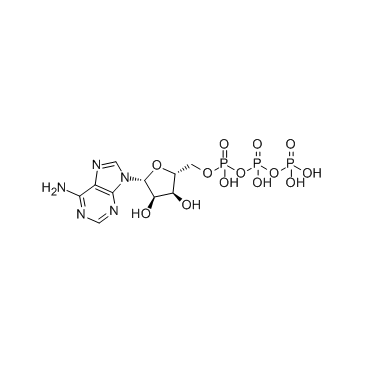ATP |
| Catalog No.GC35420 |
ATP, as a phosphate-group donor for substrate activation in metabolic reactions.
Products are for research use only. Not for human use. We do not sell to patients.

Cas No.: 56-65-5
Sample solution is provided at 25 µL, 10mM.
ATP, as a phosphate-group donor for substrate activation in metabolic reactions, is required for the biosynthesis of the intracellular second messenger cyclic adenosine monophosphate (cAMP) and mediates intercellular communication as a bona fide extracellular messenger[1]. ATP can promote tumor progression or tumor suppression.[1].
In vitro, the IC50 value for ATP, α,β-meATP, and β,γ-meATP on these P2X receptors regulating IOP (intraocular pressure) was around 1.0 µM. P2X receptors present in the ciliary body are responsible for reducing IOP. Moreover, 1.0 µM ATP under light conditions causes a reduction in IOP of roughly 50% but when darkness occurs, ATP concentration is decreased to 0.30 µM, this concentration scarcely reducing IOP more than 16%[2]. There is a obvious increase in ECM (extracellular matrix) accumulation has been found in AF (annulus fibrosus) cells at a lower ATP treatment level (20 µM) compared with NP (nucleus pulposus) cells (100 µM), suugestng that AF cells are more sensitive to extracellular ATP than NP cells[3].
In vivo test it shown that Wistar rats were treated with 25 mg/kg ATP reduced bevacizumab-induced renal toxicity significantly more effectively than benidipine (4 mg/kg)[4]. Treatment with 1 and 5 mg/kg ATP intra-arterially (i.a.) close to the bladder in rats, produced rapid, phasic, dose-dependent increases in bladder pressure with micturition immediately after injection[5].
Vultaggio-Poma V, et al. Extracellular ATP: A Feasible Target for Cancer Therapy. Cells. 2020 Nov 17;9(11):2496.
Pintor J. Light-induced ATP release from the lens. Purinergic Signal. 2018 Dec;14(4):499-504.
Gonzales S, et al. ATP promotes extracellular matrix biosynthesis of intervertebral disc cells. Cell Tissue Res. 2015 Feb;359(2):635-642.
Kocaturk H, et al. Effect of adenosine triphosphate, benidipine and their combinations on bevacizumab-induced kidney damage in rats. Adv Clin Exp Med. 2021 Nov;30(11):1175-1183.
Igawa Y, et al. Functional importance of cholinergic and purinergic neurotransmission for micturition contraction in the normal, unanaesthetized rat. Br J Pharmacol. 1993 Jun;109(2):473-9.
References:
Average Rating: 5 (Based on Reviews and 27 reference(s) in Google Scholar.)
GLPBIO products are for RESEARCH USE ONLY. Please make sure your review or question is research based.
Required fields are marked with *




